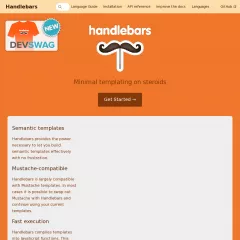Handlebars 
Handlebars is used by 0.31% of sites
Official Website
http://handlebarsjs.comCategory
JavaScript Frameworks
Handlebars.js is a popular JavaScript templating engine that allows you to generate dynamic HTML templates by combining data and template markup. It provides a simple and intuitive syntax for creating reusable templates and rendering them with data. Here are some key features and functionalities of Handlebars.js:
Templating Syntax: Handlebars.js uses a mustache-like syntax for creating templates. Templates consist of HTML markup with embedded placeholders, called "handlebars," which represent data to be dynamically inserted into the template. For example, {{name}} represents a handlebar that will be replaced with the corresponding value of the name property when the template is rendered.
Data Binding: Handlebars.js supports data binding, allowing you to bind data from JavaScript objects or JSON data to the template. You can pass data to the template as a context object, which contains the values to be substituted into the handlebars. Data binding enables dynamic rendering of the template based on the provided data.
Conditionals and Loops: Handlebars.js provides built-in support for conditionals and loops within templates. You can use {{if}}, {{else}}, and {{each}} directives to conditionally render content or iterate over arrays or object properties. This allows you to control the rendering logic based on the data being processed.
Partial Templates: Handlebars.js allows you to define and include partial templates within your main template. Partial templates are reusable chunks of HTML that can be inserted into multiple templates. This feature promotes code reusability and helps to keep your templates organized and modular.
Helper Functions: Handlebars.js supports custom helper functions that extend the functionality of the templating engine. Helpers allow you to perform complex operations or apply custom logic within your templates. You can create custom helpers to format data, perform calculations, manipulate strings, or implement any desired functionality.
Escaping HTML: Handlebars.js automatically escapes HTML characters by default, ensuring that data values are rendered as text and not interpreted as HTML markup. This helps prevent cross-site scripting (XSS) attacks and ensures the security and integrity of your rendered templates.
Extensibility: Handlebars.js is designed to be extensible, allowing you to customize and extend its functionality. You can register additional helpers, customize the template compilation process, or modify the rendering behavior to suit your specific needs.
Browser and Server-Side Support: Handlebars.js can be used both on the client-side and server-side. It can be included in web pages and executed in the browser using JavaScript. Additionally, it can be integrated with server-side JavaScript frameworks, such as Node.js, to render templates on the server before sending them to the client.
Handlebars.js simplifies the process of generating dynamic HTML content by separating the logic from the presentation. It provides a clean and intuitive syntax for creating templates and rendering them with data. Its flexibility, data binding capabilities, and extensibility make it a popular choice for front-end developers working with JavaScript-based templating.
Templating Syntax: Handlebars.js uses a mustache-like syntax for creating templates. Templates consist of HTML markup with embedded placeholders, called "handlebars," which represent data to be dynamically inserted into the template. For example, {{name}} represents a handlebar that will be replaced with the corresponding value of the name property when the template is rendered.
Data Binding: Handlebars.js supports data binding, allowing you to bind data from JavaScript objects or JSON data to the template. You can pass data to the template as a context object, which contains the values to be substituted into the handlebars. Data binding enables dynamic rendering of the template based on the provided data.
Conditionals and Loops: Handlebars.js provides built-in support for conditionals and loops within templates. You can use {{if}}, {{else}}, and {{each}} directives to conditionally render content or iterate over arrays or object properties. This allows you to control the rendering logic based on the data being processed.
Partial Templates: Handlebars.js allows you to define and include partial templates within your main template. Partial templates are reusable chunks of HTML that can be inserted into multiple templates. This feature promotes code reusability and helps to keep your templates organized and modular.
Helper Functions: Handlebars.js supports custom helper functions that extend the functionality of the templating engine. Helpers allow you to perform complex operations or apply custom logic within your templates. You can create custom helpers to format data, perform calculations, manipulate strings, or implement any desired functionality.
Escaping HTML: Handlebars.js automatically escapes HTML characters by default, ensuring that data values are rendered as text and not interpreted as HTML markup. This helps prevent cross-site scripting (XSS) attacks and ensures the security and integrity of your rendered templates.
Extensibility: Handlebars.js is designed to be extensible, allowing you to customize and extend its functionality. You can register additional helpers, customize the template compilation process, or modify the rendering behavior to suit your specific needs.
Browser and Server-Side Support: Handlebars.js can be used both on the client-side and server-side. It can be included in web pages and executed in the browser using JavaScript. Additionally, it can be integrated with server-side JavaScript frameworks, such as Node.js, to render templates on the server before sending them to the client.
Handlebars.js simplifies the process of generating dynamic HTML content by separating the logic from the presentation. It provides a clean and intuitive syntax for creating templates and rendering them with data. Its flexibility, data binding capabilities, and extensibility make it a popular choice for front-end developers working with JavaScript-based templating.